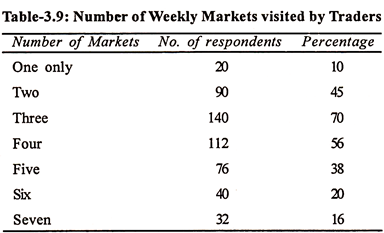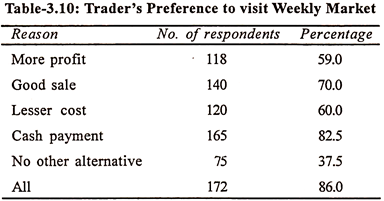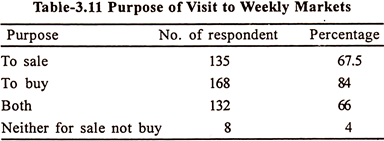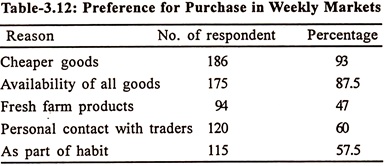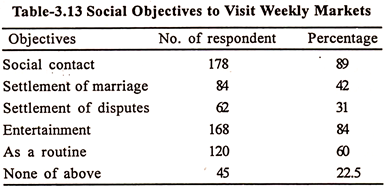Behavioural Pattern of Participants in Periodic Markets!
Periodic markets are the characteristic features of the present day developing world, as they were of medieval Europe. These markets are held periodically on some specific day or days of the week or month at some fixed sites and, thus, provide goods and services to the rural masses.
The universal phenomena of periodic marketing was disturbed by transformation of the economy and rapid growth of urbanisation and was replaced by permanent shops or markets in developed countries as well as in many parts of the developing world. But in many parts of India including Rajasthan, these markets still act as rural trading institutions.
The prevalence of periodic markets, not only in rural areas but at many urban centres indicate their importance. One of the factors of their existence is the behavioural pattern of the participants which make them successful. Therefore, the study of the behavioural pattern of participants in periodic markets is necessary not only for the understanding of their present pattern but also for their planning.
The Region of Periodic Marketing:
ADVERTISEMENTS:
The characteristic feature of periodic marketing in Rajasthan is that it is not prevalent in whole of the state, but concentrated in southeastern, southern and eastern parts of the state, that too of varying nature or intensity. In Rajasthan state, out of total 32 districts, periodic (weekly) markets have their existence only in 14 districts.
These districts are- Jhalawar, Kota, Baran, Bundi, Chittorgarh, Banswara, Tonk, Jaipur, Dausa, Sawai-Madhopur, Karoli, Dholpur, Bharatpur and Alwar. The number of weekly markets in districts varies from 57 in Sawai-Madhopur to 4 in Alwar.
The distribution of periodic markets in Rajasthan indicates that there are 265 places where weekly markets (locally known as hat or hatwada) are held in the state. In fact, periodic markets are more effective in five districts of the state, viz. Jhalawar, Kota, Baran, Bundi, Sawai-Madhopur and Banswara and least effective in Alwar, Jaipur and Bharatpur districts, because their number is too less to play any effective role in the rural economy. In Dausa, Tonk, Dholpur and Chittorgarh districts also, their number is limited and so is their role.
Periodicity:
The present day periodic marketing system in the State is an integrated spatial system beneficial to producers, consumers and traders. The controlling factor of this system is the periodicity, which provides an adjustment with agricultural system. The characteristic feature of this system is the periodicity, which provides an adjustment with agricultural system.
ADVERTISEMENTS:
Only one marketing day in a seven-day week means six rest days or days of other agricultural activity. As Good (1972, 211) has observed, marketing calendars regulate the frequency of a market and define the length of the ‘market week’ for a given area and its set of markets.
These calendars frequently have a pervasive influence on many other aspects of economic and social life. In order to understand the spatial integration of periodic marketing of activity, there is a need to discuss the nature of nesting pattern, existing in various parts of the State.
In Rajasthan, weekly markets are common in the areas already described, thus markets are held only once in a week. Only at six centres bi-weekly markets are held.
In the State, most of the periodic markets are having weekly periodicity, but at six places bi-weekly markets are also held.
ADVERTISEMENTS:
It becomes clear from the above tables that in the region understudy, Sunday markets are most common and are held at 49 centres, followed by Saturday and Monday with 44 and 43 respectively. While, the minimum number of markets are held on Thursday, i.e., 27.
Marketing System (Process):
In periodic markets of Rajasthan the marketing system is simple and direct. The profit is the primary motive of traders, middlemen as well as of consumers, therefore, there is much haggling in prices and one can see too much variations in the prices of same commodity from trader to trader and also in early and late hours of the market day.
After field work, three types of marketing system has been identified, viz. direct, through middlemen and integrated system.
(i) In direct system producer and traders reached at market place and display their goods for sale to consumers. The producer of farm products, forest products and artisans usually sale their products directly to consumers.
ADVERTISEMENTS:
(ii) In second system the role of middleman is important and he acts as a medium of sale. The middleman used to purchase produce from small producers and sale the same in traders for onward sale to consumers.
(iii) While in integrated system, producers, middlemen, traders and, of course, consumers meet at market place, settle terms and conditions and either sale or purchase the goods. This is the common system prevalent in most of the periodic markets of the state.
Participants in Periodic Marketing:
1. Traders:
ADVERTISEMENTS:
“Traders are people who are buying and/or selling goods and services in the market-place for business purposes, or who are displaying merchandise in the hope of making a sale.” In weekly markets of Rajasthan, as in case of other areas also, the traders are not absolutely busy in sale of their goods but many of them simultaneously act as a seller and a buyer.
A producer farmer sell a small portion of his farm produce and purchase the required goods. Similarly a market trader purchase products from villagers and resale them in the same market to consumers. At the same time there are traders who only sell the products. As described in review of research works, geographers have classified traders into several categories.
Our survey indicates that any classification based on single variable is not fruitful. Therefore, for present analysis we have classified traders on the basis of their residential location, time spent in trading, sex, and their functional characters.
2. Consumers:
ADVERTISEMENTS:
The consumers are the major participant of the weekly market. In other words we can say that weekly markets are primarily organised for the benefit of consumers. They exist because of consumers behavioural pattern of shopping in weekly markets. Even the intensity of trading or size of the weekly market is very much dependent upon the number of consumers.
The “consumers are the people who are buying goods or services in the market-place for consumption or use rather than for subsequent re-sale.” The potential benefits of periodicity for consumers as pointed out by Hay and Smith (1979, 30) and (i) the range of goods and services offered, (ii) the prices of goods and services, (iii) the consumer choice, and (iv) the consumer access, specially access in time.
Contrary to traders, no classification of consumers has been done.
The present survey reveals the following types of consumers used to participate in weekly markets of Rajasthan:
ADVERTISEMENTS:
(i) Consumers/purchasers
(ii) Producer-seller-cum-consumer
(iii) Middlemen-cum-consumer
(iv) Trader-cum-consumer
Another classification is based on their residence, i.e., (i) Local the residents of the same village or town where market is held, and (ii) regional or outside. Similarly on the basis of sex, consumers can be classified as male and female.
A common feature to all the markets in Rajasthan is that 30 per cent consumers are local, while 70 per cent are from outside areas. But in case of towns or cities this order has become reverse. In that case 60 to 70 per cent consumers are local and 30 to 40 per cent outsiders. Among outside participants nearly half are producer-seller-cum-consumer.
ADVERTISEMENTS:
They first sell their product, obtain money, then purchase the required goods. But rest of them are only purchasers, who attend weekly markets for their trading motives, but they often purchase commodities for their domestic use, such as vegetables, fruits, ghee, gur, sugarcane, pulses, etc. because these commodities are available cheaper and fresh in weekly markets.
The middlemen or agents are the small group of the people of market participants. In fact, these persons are link between producer sellers and traders. Sometime they simply fix the rate with a village seller and within an hour sell it to the trader with his margin of profit or commission.
For example a middleman contacts a seller and purchase 10 kilogram of vegetables in 15 rupees and ask the seller to wait for an hour for payment. Within an hour he contacts to the trader and sell the same in Rs.25, thus having a margin of Rs.10 in one deal. In a day he used to perform 15 to 20 such deals.
In other cases he just sits at a vintage point of road side specially on the routes from where rural people come and purchase foodgrains, pulses, spices etc. from villages, and who bring in small quantity varying from one kilogram to ten kilogram. He used to make payment in cash and by the end of the day either sell the whole quantity to a wholesale dealer or bring it to his home town.
ADVERTISEMENTS:
Apart from main participants discussed above it has been observed that about 10 per cent of people attend weekly market just as routine or for fun or just “by standards and passersby.” Sometimes all the members of the family use to attend the market including elders and children where purchases are done by elders and others go-round the market for the change in routine life.
In tribal weekly markets of Banswara district and southern part of Chittorgarh district there is a rush of female participants in colorful dresses and it is known that often brides are selected by young male participants in these markets.
Classification of Traders in Rajasthan:
The classification is as follows:
Classification of traders based on:
(A) Residential Location:
(i) Local,
ADVERTISEMENTS:
(ii) Outside.
(B) Time Spent in Trading:
(i) Part-time, and
(ii) Full-time.
(C) Functional Character:
(i) Producer sellers –
ADVERTISEMENTS:
1. Farmers, and
2. Artisans and others.
(ii) Buyer sellers,
(iii) Sellers of manufactured goods,
(iv) Others.
(D) Sex:
ADVERTISEMENTS:
(i) Male Traders,
(ii) Female Traders.
Local and Outside Traders:
In weekly markets of Rajasthan, the traders can be broadly classified according to their location of residence as local and outside. The local traders are those, who are resident of the same village/town where weekly markets are held; while the outside traders have their home based at some other place and reach market on market day.
Part-Time and Full-Time Traders:
The traders in weekly markets can be classified as part-time and full-time traders. The part-time traders are those whose primary occupation is other than trading but they act as traders in weekly markets. All the farmers are in this category, their main occupation is agriculture but they sell their products in weekly market on market day.
Similarly many craftsmen and artisans are also part-time traders, because on market-less days they repair or sell their goods at their home or at workshop. Tailors, carpenters, blacksmiths, barbers, cycle-repairers, etc. and all those shopkeepers who have their permanent shops but shift at market site on market day are included as part time traders.
On the other hand full-time traders used to visit one after another market and act as mobile traders in weekly markets. The main occupation or source of income is trading in weekly markets.
Classification Based on Functional Character or Nature of Enterprise:
Traders in periodic markets can be classified on the basis of nature of enterprise or functional character. Actually this type of classification is based on nature of commodities he or she sold in the market. A trader may be a producer of a commodity as in case of farmers, who are producer-sellers of the agricultural products like vegetables, fruits, and also small quantity of pulses and food grains.
Similarly, the carpenters, blacksmiths, cobblers, kumhar (maker of earthenware), tailors, etc. are also producer of their own products. On the other hand, there are buyers and sellers. In this category only those traders have been included who buy commodities in the early hours of market and resale them in the late hours.
The vegetable sellers and food-grains sellers are major group in this category. While the sellers of manufactured goods deals in various types of articles like cloth, plastic goods, general merchandise, salt, kerosene oil, etc. Apart from them there are traders or shopkeepers who provide only services or other items not included in above mentioned categories.
Male-Female Traders:
Periodic market traders can be conveniently divided into male and female traders on the basis of their sex. Female sellers generally sells vegetables, handicraft products like earthen wares, bamboo-baskets, ropes and items used by ladies, while the male traders usually deals in all the items.
There is also a need to study the social structure of the traders in weekly markets. Because caste structure plays a vital role in trading activities in traditional societies like India. In present case this analysis has not been possible because of very little response of traders on the question of caste. They avoid to answer the questions on caste.
Similarly is the case of their daily income. In 90 per cent cases they refuse to answer questions on income. The mode of travel used by traders varies from foot to cycle, bus, and some time also horse, donkey or bullock cart.
Behavioural Pattern of Market-Place Participants in Rajasthan:
Market participants are the key components, which make the market places as effective functional unit as well as a place of economic and social interaction. The behavioural pattern of market participants is the most important factor in the existence and functioning of weekly markets not only in Rajasthan and India but throughout the world.
It is the behavioural pattern of market participants which makes them an economic institution. In spite of the development of permanent markets, their continuation during present economic setup is only due to behavioural pattern.
The behavioural pattern of market participants is a complex areal phenomena and is determined by various factors like:
(i) Nearness to market,
(ii) Easy accessibility,
(iii) Size of the market,
(iv) Specialization of market trade in particular commodities,
(v) Profitability, and
(vi) Economic and social relations.
The present analysis of the behavioural pattern of market participants, viz., traders and consumers is based on intensive field work, thus, reflecting the nature of trading and spatial interaction between participants.
Behavioural Pattern of Traders:
Generally, it can be said that the traders used to travel longer distances to sell their goods. The traders tend to confine their activities to a set of markets, which together forms, a system, known as market cycle. Their spatial pattern of trading is influenced by their economic status as well as by their commodities they deal in and also by their methods of maximising return on investment.
Therefore, traders used to visit less number of markets, because they cannot afford to visit all, or visiting many markets is difficult for reasons like limited goods, mode of transport they adopt or even location of markets, etc. The number of markets visited by traders in a week varies from one to, seven as given in the table-3.9.
It becomes clear from the above table that about 32 traders used to visit seven weekly markets followed by 40 six and 76 five markets. The traders who used to visit four markets is 56 per cent. Most of the traders 70 per cent visit three markets in a week. While 45 per cent used to visit two markets. Remaining 10 per cent only visit one market place in a week. Generally, traders used to visit the nearest or most accessible markets from the home to minimize the costs on transportation.
During field work a question has been asked to traders why they do business in weekly markets or what is the motive of their visit? The table-3.10 is the result of their answers.
It becomes clear that traders choice to trade or sale in weekly markets is due to several motives like, more profit, good sale, lesser cost, cash payment, no other alternative and all. Cash payment and good sale is of primary concern as indicated by 82.5 per cent and 70 per cent respectively while less cost and more profit is also a consideration for 60 and 59 per cent traders. Only 37.5 per cent traders are of the opinion that they do not have any other alternatives.
Behavioural Pattern of Consumers:
Consumers are the main participants and their behavioural pattern is a determining factor of the present status of the market as well as their future existence. The area limit of consumer is more a result of spatial pattern of markets as well as physiographic factors. As described earlier consumers in these markets are also sellers. The table-3.11 is the result of field work regarding purpose of their visit to market.
It becomes clear form the table that 67.5 per cent people used to visit periodic markets to sale their goods while 84 per cent to buy. Out of these 66 per cent to both these function, there are 4 per cent persons who attend market just as standbys.
The most important aspect of consumer behaviour is their preference for purchase, i.e., why they visit weekly markets? The table-3.12 indicates the preference pattern.
It becomes clear that most of the consumers used to visit these markets for more than one purpose. The availability of cheaper goods is the main cause while personal contact with relatives and other members of community is also a main factor. About 60 per cent visitors are not confident about their answer and say that they visit these markets just as a routine.
Visit to weekly markets is also done for social contact. The table- 3.13 based on field work indicates the social objectives of the visitors.
It becomes clear from the table-3.13 that social objectives are also important, which make these markets as a social institution. In fact, behavioural pattern of market participants vary from persons to person, his economic status as well as level of literacy.
But it becomes clear from over all analysis that the study of behavioural pattern of these markets should be done intensively. The present attempt is just an elementary one for planning strategy. More detail study will be required for each geo-economic regions of the state.
In brief, the weekly markets are held for the benefit of market participants. Although, the motive of participation varies, but each of them form the integral part of the marketing system. The behavioural pattern of market participants is the primary reason of the survival of periodic markets not only in rural areas but in towns of the Rajasthan state.
